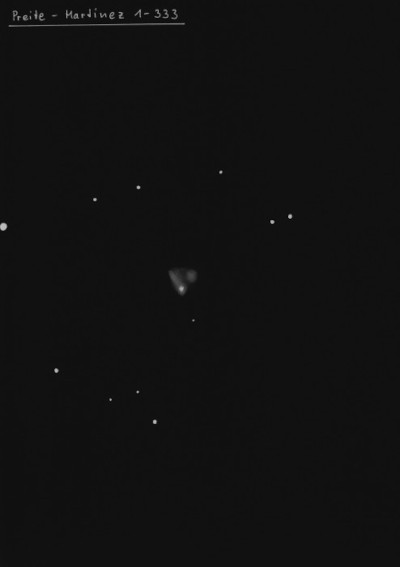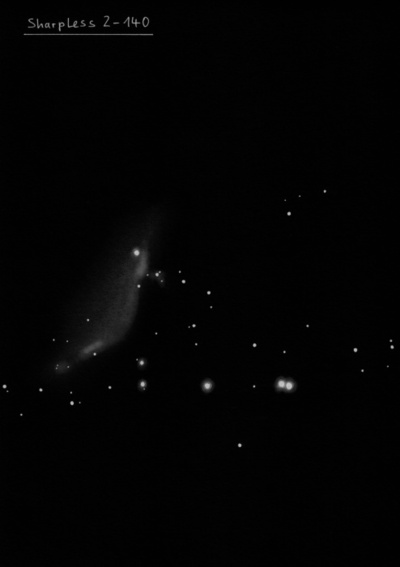A constellation of the northern sky extending to the celestial pole, which does not fit in our latitudes. It is formed by a rhombus lying at the elongated junction of the Big Dipper with Polaris, which peaks at midnight in late August near the zenith, and is therefore best seen in the evening during October and November. We can help us find it by using, for example, Cassiopeia - it is pointed at the 2 times elongated conjunction of the stars Shedir and Caph. Cepheus is a relatively inconspicuous constellation sandwiched between the brighter and easier to distinguish Cassiopeia and the Cygnus, although its star shape, resembling the drawing of a child's house, is easy to find under average viewing conditions: α, β, ζ and ι Cephei represent the corners of this house, with γ Cephei at the tip of its roof. The southern part of the constellation also extends into the Milky Way, and at first glance it would appear that there is not a single interesting deepsky object to be found here. But there isn't. You need to get your hands on a better binocular or at least a smaller telescope! Surprises start to emerge from the endless depths of space in the form of interesting stars, clusters and nebulae.
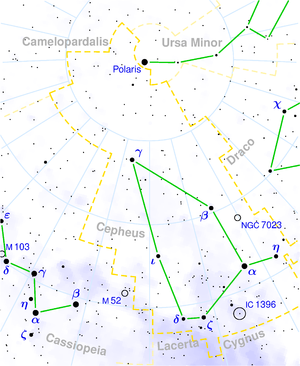
From the emission nebula IC 1396, a hazy but still clearly visible Milky Way bulge penetrates the Cephean rhombus, separating a narrower, darker bay in the direction of the ζ-ι Cephei line from the main Milky Way stream (continuing on to Cassiopeia). It is brightest in the vicinity of stars 18, 19 and 20 Cephei, which together with a few other fainter stars form a brightening of about three degrees. If observing conditions allow you to see even faint stars, the moon isn't exactly in the sky, and someone decides to turn off the public lighting in the area, it's worth noting that the Milky Way continues on to γ Cephei (where it is closest to Polaris) and only ends in a hazy arc at brightening at the point where most star atlases plot the large open cluster Collinder 463. Between this arc and the mainstream, a chain of dark nebulae (the Second Great Rift) very similar to the one in the Cygnus becomes apparent.
Alderamin (α Cep) - The brightest star of the constellation has a magnitude of 2.44. It is a yellow-white star of spectral class A7, located 49 light-years away from us, forming a quadrilateral with the stars β (magnitude 3.21), ζ (magnitude 3.35), and ι (magnitude 3.52). In its center lies the star ξ Cep. Due to the precession of the Earth's axis, Alderamin will become the closest star to the North Celestial Pole around the year 7500 AD. It has a luminosity 17 times greater than that of the Sun.
Alfirk (β Cep) - A double star distinguishable by a small telescope with a 6 cm diameter objective, consisting of two components with magnitudes 3.2 (bright white) and 7.9 (blue - appearing emerald green in a large telescope) at a mutual distance of 13.3". The primary star is also a spectroscopic binary, with an orbital period of only 4 and 3/4 hours. In the same period, it exhibits a slight change in brightness between magnitudes 3.3 and 3.4. It is even a prototype of a group of variable stars called beta Cepheids, whose brightness fluctuations are so small that they can hardly be observed with the naked eye. It is located at a distance of 690 light-years.
δ Cephei - Together with the stars ε (4.19mag) and ζ Cep (3.35mag), it forms a small triangle. While these two stars are constant, δ Cephei changes its brightness regularly due to pulsation. The entire group of variable stars - delta Cepheids - is named after this star. The variability of δ Cephei was discovered in 1784 by the twenty-year-old John Goodrick, a deaf-mute English amateur astronomer of Dutch origin (he discovered three variable stars, thoroughly studied the brightness changes of the star Algol, and correctly explained them at the age of 19, two years later he died at the age of 21). In its brightest form, the star reaches a magnitude of 3.48, while in its minimum it has a brightness of 4.37mag, so these changes can be easily observed with the naked eye. Its period is 5.37 days. Astronomers use Cepheids to estimate distances in the universe.
Erakis (μ Cep) - The star, due to its striking dark red color, was named "Granátová hvězda" (Garnet Star) by William Herschel - it belongs to the reddest stars in the entire sky, which is easily verifiable even to the unaided human eye. Even in a small telescope, it provides a nice view. Gradually, when observed with a larger telescope, it can take on an orange-red or orange-yellow hue. It has a surface temperature of only 3,500 K, while its diameter is 70 times larger than that of the Sun. This M-type spectrum star is actually much brighter in comparison to another known red supergiant - Betelgeuse in Orion, it is at least as bright as 174,000 Suns and has an absolute magnitude of -8.3. We perceive it as a faint star in the sky only because of its large distance of 2,800 light-years.
Al Kurhah (ξ Cep) - This physical binary star consists of two components with magnitudes of 4.6 (white) and 6.5 (yellow-brown) at a separation of 8", which can be resolved by a telescope with an objective diameter larger than 6 cm under ideal conditions. Their distance from Earth is determined to be 86 light-years. They are peripheral members of the "Taurus moving group" primarily associated with the open star cluster Hyades.
VV Cephei - Red supergiant, component of an eclipsing variable star, which changes its apparent brightness from 4.9 mag to 5.7 mag over a period of 20 years. It was once considered the largest known star in the observed part of the universe. It has a diameter 2,400 times larger than the Sun, with an average density only one three-millionth of the density of water. Its distance from Earth is 5,000 light-years.
Kruger 60 - Although invisible to the naked eye, it is otherwise a well-known and interesting binary star. It lies 43' south of δ Cephei. To resolve the primary component with a brightness of 9.8 mag and its companion with a brightness of 11.3 mag, a minimum of a 120 mm telescope and high magnification will be needed, as they are separated by 2.4 arcseconds. It is located at a distance of only 13.1 light-years, making it one of our closest binary stars. The orbital period of these red dwarfs is only 44.5 years. Their average distance is 1.4 billion km, which is equivalent to the distance between the Sun and Saturn. The mass of the primary star represents about 0.25 times the mass of the Sun, and the mass of its companion is even only 0.15 times the mass of the Sun, with their luminosity being even smaller.
U Cep - The interesting short-period variable star. The brighter B-type component is eclipsed by a larger, but fainter G-type giant every 2.5 days. It changes in brightness from 6.7 mag to 9.2 mag, with a four-hour descent to minimum followed by two hours of total eclipse. Due to the close true separation, the brighter component pulls a significant amount of mass from the outer layer of the faint giant, resulting in a shortening of the orbital period by 4 minutes over the past century. The nearby third component appears to be part of the system as well, but it does not orbit along this path.
NGC 7380
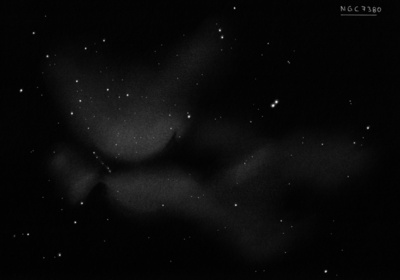
Caroline Herschel discovered NGC 7380 = H VIII-77 = h2182 on 7 Aug 1787 with her 4.2" comet-sweeper reflector. William rediscovered it on 1 Nov 1788 (sweep 876) as "a Cl of coarsely scattered stars 7' or 8' diameter." His position is accurate. John Herschel called it "a L, p rich, v coarse cl of stars 9.10 m and below." On a second sweep he noted "A double star, the chief of a fine, p rich, L cluster, 10' dia; stars 9...13m."
300/350mm - 13" (10/26/80): ~30-35 stars in a triangular outline, 10'-12' in diameter but not rich.
400/500mm - 17.5" (10/30/99): at 100x with an OIII and UHC filter appears as a bright triangular-shaped nebulosity (Sh 2-142), 8'-10' diameter, superimposed on a rich cluster of stars (NGC 7380) within a rich Milky Way field. The brightest member, mag 8.5 DH Cep, a very rare spectroscopic eclipsing pair of massive O5.5/O6.5-type stars, is at the west vertex. Also a wide strip of nebulosity is attached near the southeast vertex and extends to the southwest. A dark band appears to separate this strip from the triangular patch. The surrounding region appears weakly nebulous and the "edge" can be traced with some certainty further the north. DH Cep is the main ionizing source of the nebula.
17.5" (7/31/92): at 100x, about 40 stars in a 10' diameter. The brighter stars form a "V" or chevron pattern. The brightest star is at the west tip of the "V" and is an unequal double mag 8.6/13. The cluster appears to be encased in nebulosity especially from the mag 8.6 star to the star at the east tip of the "V". Using an OIII filter the nebulosity is quite prominent with some structure and encases the entire cluster. A lane of nebulosity oriented SW-NE extends beyond the cluster from the star at the east end of the "V" and nebulosity also extends west of the mag 8.6 star. The double star O∑480 = 7.6/8.6 at 30" is in the field to the west.
Notes by Steve Gottlieb
NGC 40
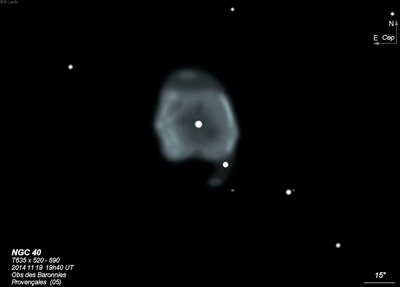
William Herschel discovered NGC 40 = H IV-58 = h8 on 25 Nov 1788 (sweep 886) and recorded, "a star about 9th mag, surrounded with vF milky nebulosity; other stars of the same size are perfectly clear from that appearance. The star is either not round or double; but I am in the north and above the pole, I could not view it sufficiently to determine it. Less than 1' in diameter." On 20 Nov 1829 (sweep 228), JH logged "a star 11m with a luminous atmosphere 30" to 40" diameter." On 29 Oct 1831 he noted "a * 10m with strong nebulous atmosphere 15" diameter. Exactly round and pretty suddently fading away makes a double star class 5 with a star preceding."
Based on Crossley photographs, Curtis (1918) described, "Central star about mag 10. The nebula resembles a truncated ring from the ends of which extend much fainter wisps. The brighter central portion is 38"x35" in PA 14°, while the total length along this axis is about 60"."
200/250mm - 8" at 100x; a bright central star is surrounded by an easy halo.
300/350mm - 13.1" (12/7/85): at 166x, bright central star visible centered within a fairly small prominent disc.
13.1" (10/12/85): moderately large, bright central star surrounded by a moderately bright halo at 166x and 214x using a UHC filter.
400/500mm - 17.5" (12/30/99): at 100x appeared (unfiltered) as a slightly elongated, moderately bright disc surrounding a bright mag 11.5 central star. A slightly fainter mag 12 star lies 1.0' SW. This is a low excitation PN with an OIII/H-beta ratio of just 0.4 and at 100x there was a noticeable enhancement using the H-beta filter, while it dimmed with an OIII filter. At 220x, a star was intermittently visible at the SW edge and the PN was slightly elongated SSW-NNE. The UHC filter gave the best response at this power. The surface brightness appeared irregular -- darker around the central star and slightly brighter along the west and east side of the rim. At 280x, the faint star I noted earlier was barely off the SW edge and the PN was weakly annular with a brighter rim along the west and east side and a darker center. The SW and NE ends of the halo were clearly weaker, though. 380x provided a nice view with subtle irregularities in the interior.
17.5" (11/1/86): bright, moderately large, round. Contains a prominent mag 11.5 central star surrounded by a fairly bright halo.
900/1200mm - 48" (10/23/14): this showpiece, annular planetary was observed unfiltered (low-excitation) at both 488x and 813x and a remarkable amount of detail was visible. The main section of NGC 40 is nearly round and 0.7' in diameter but outer extensions on the north and south ends increase the dimensions to roughly 1.0'x0.8' SSW-NNE. The darker interior surrounding the blazing mag 11.5 central star (WC8-type carbon Wolf-Rayet) has a very uneven surface brightness and is slightly darker to the southwest of the central star.
The irregular rim in much brighter along fairly narrow N-S strips on the west and east side. The western rim is the brighter one and somewhat patchy with a slightly darker notch to the south of its center. At its north end is a small, faint extension. The rim is more uniform in brightness on the eastern side.
A very faint, thin outer loop curls north and west at its north end of the main disc! A small, detached, elongated patch floats near its north edge, but slightly south of the tip of the outer loop to its east. A very faint star or stellar knot is involved in this patch.
The rim is very weak on the south side and an easy star is at the southwest end. A faint, very small detached piece was easily visible at the southern extremity [32" SSW of the central star] of NGC 40. This patch forms the eastern vertex of a small triangle with a star ~10" NW (noted earlier) and a fainter star 10" SE.
Notes by Steve Gottlieb
IC 1396
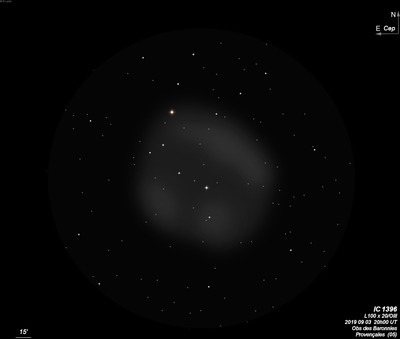
16x80 (9/29/84 and 8/26/89): using a UHC filter appears as a very large, irregular nebulous glow (about 2° diameter). Very faint but definite when compared without filter. Surrounds ∑2816 = 5.8/7.7 at 12" and a large, faint, scattered star group. Visible without a filter as an extremely large, hazy region surrounding ∑2816 and fainter stars.
E.E. Barnard discovered IC 1396 on a photographic plate taken with the Willard lens in 1893. He commented in "Photographic Nebulosities and Star Clusters connected with the Milky Way" (Astr. & Astro-Phys. 13, 177-182 (1894)) that "A magnificent specimen of these [nebulous masses] I have found on one of my plates in Cepheus which was given an exposure of seven hours. This a mixture of bright stars and nebulosity. The diffused portion of this nebulosity conforms in its peculiarities with the general structure of the Milky Way, showing it be actually mixed up with the ground work of star. The brightest star of this group is DM +56° 2617."
400/500mm - 18" (7/11/10): Barnard 161 is an easy 6' circular dark patch within IC 1396 (north of center) just 13' N of ∑2819 = 7.4/8.7 at 13" and 25' NE of the triple star ∑2816 = 5.8/7.7/7.8 at 12" and 20". Stands out fairly well at 73x. There are extensions to the north of this cometary dark nebula that I didn't see.
Notes by Steve Gottlieb
NGC 7023
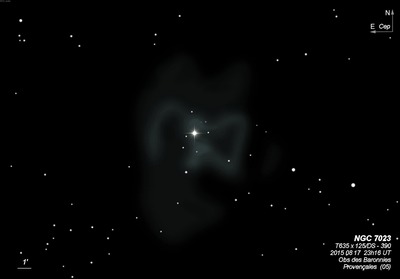
William Herschel discovered NGC 7023 = H IV-74 on 18 Oct 1794 (sweep 1063) and recorded "7m. A star very much affected with nebulosity that more than fills the field, it seemed to extend to at least a degree all round; small stars such as 9 or 10m of which there are a great number, are perfectly free from this appearance, but everything about the telescope being very damp, I have suspicion of a deception." Per Collinder mistakenly equated a cluster (Cr 429) with NGC 7023. Cr 427 is a very faint cluster close west, though Archinal and Hynes noted "His position for Cr 429 fall precisely on the actual location for the real cluster here, Cr 427. And Collinder's position for the real cluster falls 1 minute to the west of it on comparitively empty sky."
In 1907 Max Wolf photographed the nebula with the 28" reflector of the Konigstuhl Observatory and found the nebula was encircled by a lacuna or ring 0.5° in diameter, which is "absolutely empty of faint stars" [dubbed a "Hohlennebel" or "cave-nebula"] . He noted "In spite of the small field of the reflector-plate, there was evidence that the cavity was the end of a channel entering the picture almost exactly from the south...The nebula itself is a very remarkable object. In many respects it resembles in form the Pi2 Cygni nebula [IC 5146 = Cocoon Nebula]." The surrounding void was first photographed by Dr. Roberts. The reflection nebula vdB 152, also in Cepheus, is another example.
200/250mm - 8" (8/28/81): nebulosity extends south of the mag 7.5 star with averted vision using 100-125x. A very faint star is at the south edge.
300/350mm - 13.1" (9/22/84): the dark lane appears to be following the central star and oriented ~N-S.
13.1" (9/11/82): bright, large nebulosity surrounding a mag 7 star. There is a sharp light cut-off on the east side near the bright star, although nebulosity extends beyond.
400/500mm - 17.5" (8/13/88): very prominent unusual nebulosity surrounding mag 7.4 SAO 19158. A dark lane oriented SSW-NNE is following the bright star. Nebulosity may extend to a star 3' SSE that also has a halo.
Notes by Steve Gottlieb
NGC 6939
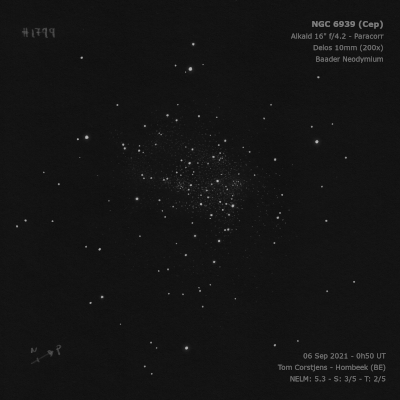
William Herschel discovered NGC 6939 = H VI-42 = h2083 on 9 Sep 1798 (sweep 1077) and described "a beautiful compressed cluster of small stars, extremely rich, of an iF. The preceding part of it R and branching out on the following side; both towards the north and towards the south; 8 or 9' diam." JH made 4 observations and logged on sweep 366 "very fine rich cluster; 5' diam; stars 12m and nearly equal; shape rather convex towards the preceding side."
300/350mm - 13" (7/5/83): ~70 stars resolved at 166x, very rich, beautiful in faint stars.
400/500mm - 17.5" (9/14/85): about 100-140 stars mag 12-15 are resolved. Difficult to count as stars fill the 22' field at 220x with no distinct boundaries. NGC 6946 is located less than 40' SE.
Notes by Steve Gottlieb
NGC 188
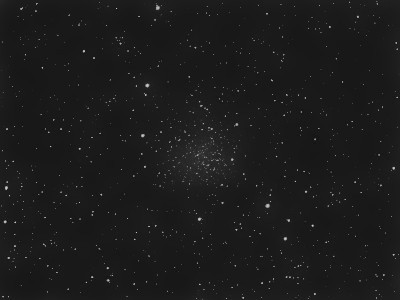
John Herschel discovered NGC 188 = h34 on 3 Nov 1831 and recorded a "Cl, vL, p Rich, 150-200 stars mag 10-18; more than fills the field." The Sky Catalogue 2000.0 gives a poor position of 00 44.0 +85 20.
200/250mm - 8" (8/24/84): large cluster, many faint stars, not rich, blank areas near center.
300/350mm - 13.1" (8/24/84): about 50 stars at 62x with several mag 7-9 stars in field, appears fully resolved.
400/500mm - 17.5" (12/26/00): At 100x, ~75 stars resolved within 10'-12', roundish group. The cluster is fairly rich but unconcentrated, with a noticeable void of stars near in the center and a somewhat ill-defined boundary. The stars appear to be layered; at least a dozen mag 12-13 stars are superimposed on a much richer carpet of mag 14-15 stars over unresolved haze. At 220x, some additional very faint stars are visible, bringing the total up to ~85 stars. Two mag 9.5-10 field stars (SAO 109 and 11) are just off the west edge and mag 8.7 SAO 149 is beyond the ENE border.
NGC 188 is one of the older known open clusters with an age of ~6.3 billion years and the closest to the north celestial pole.
Notes by Steve Gottlieb
NGC 7354
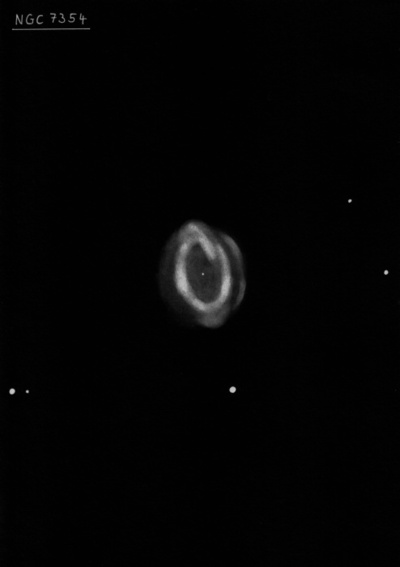
William Herschel discovered NGC 7354 = H II-705 = h2178 on 3 Nov 1787 (sweep 773) and recorded "pB, S, irr R, er, almost of an equal light throughout." JH noted it was "B enough to be noticed and caught in sweeping in full moonlight, with the moon on meridian; pgbM; R; no nucleus seen." NGC 7354 was the most northerly object observed with the Lord Rosse's 72", culminating 8° beyond the zenith.
Based on Crossley photographs taken at Lick, Heber Curtis (1918) reported "a somewhat irregular oval ring, fading out at each end, 22"x18" in p.a. 27°. Outside this is a ring or disk of much fainter matter, rather more circular in form and 32" across from east to west. This outer portion likewise is fainter at the ends of the major axis, and shows brighter streaks at the east and west edges."
200/250mm - 8" faint, small, round, but easily visible at 100x or higher and takes 200x. Very faint star is at the SW edge.
300/350mm - 13.1" (7/12/86): fairly bright, fairly small, slightly elongated. A mag 14 star is just off the SW edge. Pretty with a UHC filter at 166x, estimate V = 12.0. Takes high power without a filter.
400/500mm - 17.5" (11/6/99): a fairly bright, 25" disc is visible at 100x with one or two stars very close. At 280x, the PN is slightly elongated E-W, ~25"x20". A mag 14 star is close off the SW edge, 30" from center and a mag 14.5 star is 0.6' due west. At 380x, a mag 15-15.5 star is 0.6' WNW. In addition, the surface brightness is noticeably irregular with hints of brighter areas.
600/800mm - 24" (8/30/16): at 375x; fairly bright, fairly small, slightly elongated SW-NE, ~25"x20". The rim is brighter along the southeast side and very slightly brighter along the northwest side. The rim dims on the northeast side. A mag 14 star is 0.5' SW, a mag 14-14.5 star is 0.8' W and a mag 15 star is 0.7' NW. At 500x, the planetary clearly has a mottled appearance with what appears to be several very small brighter spots that wink in and out.
Notes by Steve Gottlieb
NGC 7538
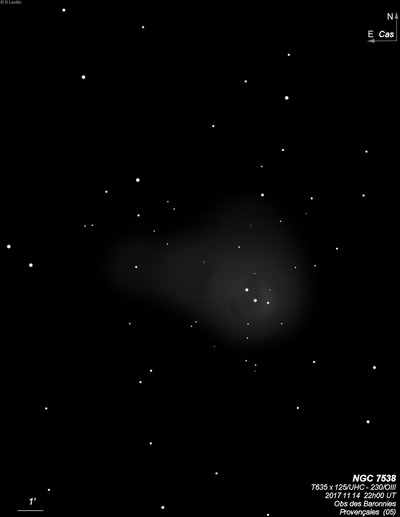
William Herschel discovered NGC 7538 = H II-706 on 3 Nov 1787 (sweep 773) and recorded "vF nebulosity of 3 or 4' extent, contains two considerable stars, but they do not seem to be connected with it." On 26 Nov 1788 (sweep 887) he noted "2 pS stars involved in nebulosity, about 2' l and 1 1/2' broad, pBM." In his 1814 PT paper WH argued that this was too unusual to be line of sight arrangement and the stars had formed within the nebula! Ralph Copeland sketched the nebula using LdR's 72" in Sep 1873 and showed two extremely faint, curved thin "tails" extending east and west.
200/250mm - 8" faint nebulosity with two mag 12 stars involved. Appears elongated and fairly large. Easy to view with averted.
400/500mm - 17.5" (8/10/91): fairly large elongated emission nebula 2.0'x0.75' oriented NW-SE. Surrounds two mag 11.5 stars oriented SW-NE (PA = 35°) with a separation of 30". The nebulosity extends SW of the pair and is brightest just west of the pair. A mag 15 star is at the SW end and a mag 14 star is 30" W of the southern mag 11.5 star. At 100x using an OIII filter the nebulosity is very bright and a fainter glow also extends east of the pair to a size of 3'x2'.
Notes by Steve Gottlieb
NGC 7129
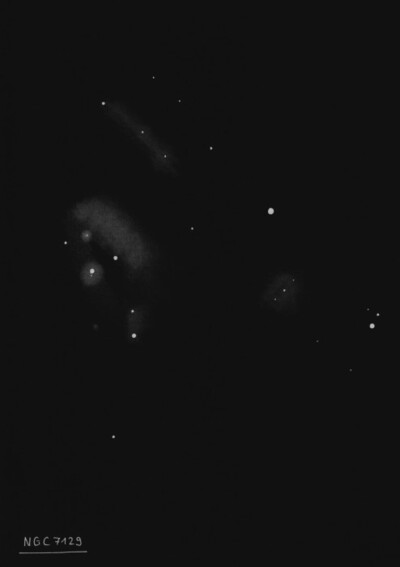
William Herschel discovered NGC 7129 = H IV-75 on 18 Oct 1794 (sweep 1063) and recorded "3 stars about 9m involved in nebulosity. The whole takes up a space of about 1.5' diam, 2 other stars of the same size and very near are not enclosed in the nebulosity." On 16 Sep 1798 (sweep 1079) he logged "3 stars about 9-10m involved in nebulosity; 2 sp stars very near them are free from that appearance. The nebulosity is of the milky kind and considerably strong. There is a small 4th stars in the nebulosity just north of the following one." John Herschel's description is similar: "a very coarse triple star involved in a nebulous atmosphere." On a second observation he gives the relative offsets for the 3 stars (A, B and C), which match my observation. His mean position for star A (southern star) is: 21 42 59.0 +66 06 12 (2000). Both father and son clearly refered only to nebulosity surrounding a few stars at the position given here.
Guillaume Bigourdan's position and description for IC 5134 = Big. 339, found on 15 Oct 1895, clearly applies to the nebulosity around star A only, as he thought NGC 7129 only applied to one of the northern patches. So, IC 5134 is part of NGC 7129. IC 5132 and IC 5133 refer to separate fainter reflection nebulae surrounding two mag 12 stars ~4' north-northwest, which were discovered by Isaac Roberts in 1895 on a photographic plate. Bigourdan's NGC 7133 = Big. 91, placed ~10' northeast of NGC 7129, is free of nebulosity and Harold Corwin concludes does not exist. The RNGC position for NGC 7129 is off by 1.7 minutes of RA and NGC 7133 is misidentified.
300/350mm - 13" (7/20/85): fairly bright with OIII filter but dims using a Daystar 300 filter. This nebulous region includes four or five stars and appears brighter around these stars. A small knot is at the north end and a second knot is at the south end.
400/500mm - 17.5" (10/17/98): fairly high surface brightness nebulosity ~3'x2', surrounding three mag 9.5-10.5 stars at 220x. At 280x, the brightest region surrounds the southern star (IC 5134) and the star 1' to its northeast. Just preceding this second star is a small knot that does not appear to be surrounding a star. The third star is 1' northwest the southern star and has the weakest halo. An additional pair of stars 1.5' and 2' southwest do not appear to be surrounded by halos. The entire group is encased in a diffuse glow and the surrounding region appears to be dusty. IC 5132/5133 are very weak nebulae surrounding two mag 12 stars ~5' NNW.
17.5" (9/23/89): fairly bright reflection nebula surrounded three bright stars. The brightest portion includes the southern star. Also a bright knot is at the north end and it does not appear to be surrounding a star (or the star is embedded).
Notes by Steve Gottlieb
NGC 7139
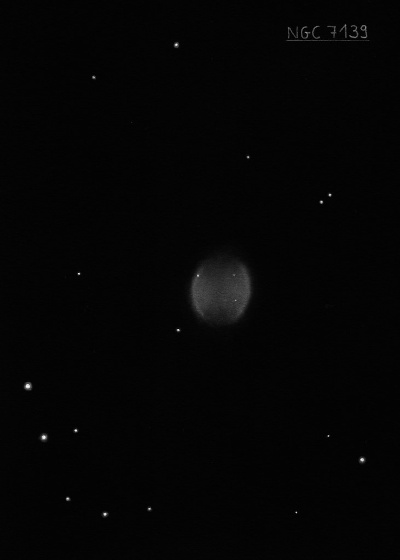
William Herschel discovered NGC 7139 = H III-696 on 5 Nov 1787 (sweep 775) and recorded "vF, iR, may be a patch of stars but I have not been out long enough, about 1' diam." His position is within 2' of this planetary. Four nights later (sweep 776) he reported "vF, S, R, lbM, r." On 15 Oct 1794 (sweep 1062), he noted "F, irr figure, easily resolvable." On this sweep, his position is just 1.3' too far south. John Herschel didn't record an observation. Bigourdan measured an accurate position on 24 July 1884.
Heber Curtis first found the spectrum to be of a planetary with a slitless spectrograph at Lick. Based on a Crossley photograph. Heber Curtis reported (1918) "the oval is 86"x67" in p.a. 20° +/-. Considerably fainter along the major axis; at the east and west edges slightly brighter streaks appear, indicating a ring or shell formation."
The declination is 8.5' too far south in the RNGC, Sky Catalogue 2000, Strausberg-ESO Catalogue, NGC 2000.0 and the first edition of the Uranometria 2000 Atlas. The position is correct in the NGC and the P-K catalogue. Kent Wallace was first to note the positional error.
200/250mm - 8" (8/28/81): extremely faint, moderately large, round, difficult, a faint star is near the south edge. Located about 4' NW of a faint curving arc of stars and 23' E of mag 7 SAO 19595. This is one of the faintest planetaries observed with the C8.
400/500mm - 17.5" (10/13/01): easily picked up sweeping at 100x without a filter. Appears moderately bright, round, 1.2' diameter, crisp-edged. A mag 13.5 star is off the SE edge. Excellent view at 280x without filter. The surface brightness appears irregular with a slightly brighter rim, particularly along the eastern half of the rim. An extremely faint star is intermittently visible right at the NE edge. A nice, elongated group of 6-8 stars follows the planetary in the same high power field. Central star not seen at 280x.
17.5" (8/8/91): moderately bright, fairly large, slightly elongated, 1.2' diameter. A mag 13.5 star is just off the SE edge 40" from the center. A slightly darker center is visible with an OIII filter at 140x but the annularity is subtle. No central star visible.
600/800mm - 24" (8/31/16): excellent contrast gain using a NPB filter at 200x. With this combination NGC 7139 is fairly bright, round, crisp-edged, 1.2' diameter. The rim is slightly brighter, particularly on the east and west sides and slightly weaker on part of the north and south rim, giving a subtle annularity. The interior is unevenly lit, and a bit darker on the north-northeast side. A mag 13.5 star is off the southeast end [0.9' from center] and a mag 15.5 star is right at the northeast edge of the rim.
Notes by Steve Gottlieb
NGC 7234
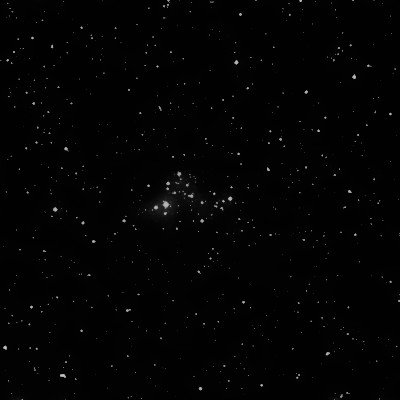
A compact group of faint stars 13' S appears as a small, partially resolved nebulous glow at 100x. At 220x, 7 stars are resolved from mag 14-15.5 within a 1.5' diameter. I had taken this as NGC 7234 but Corwin's re-reduced position from William Herschel indicates that NGC 7234 is identical to NGC 7235.
John Herschel found NGC 7235 = h2154 on 16 Dec 1830 and recorded "a * 10m, the chief of a p compact cluster of 15 or 20 stars 10...17m. One, 11m, is of a ruby colour." His position (measured on two sweeps) is accurate. JH equated this object with his father's H VIII-63 = NGC 7234, but they were given separate GC and NGC designation, due to an error in precessing the position of NGC 7234. So, NGC 7235 = NGC 7234.
400/500mm - 17.5" (11/2/91): two dozen stars mag 9-15 in a 4' diameter at 220x. This moderately concentrated group is elongated WNW-ESE and includes several fairly bright stars. A mag 9 star is at the east end and there are eight other mag 10-11 stars. Just west of the mag 9 star is a 1.5' circular hole with no stars. A mag 10 star at the extreme west edge has 6 faint stars mag 13/14 close following.
Notes by Steve Gottlieb
NGC 7510
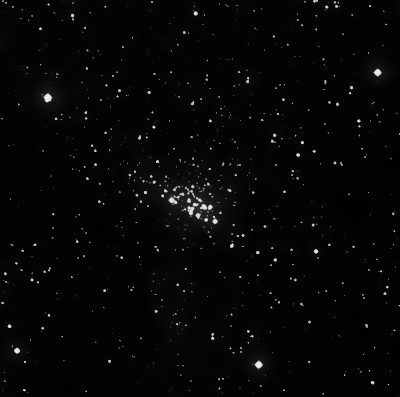
William Herschel discovered NGC 7510 = H VII-44 = h2213 on 3 Nov 1787 (sweep 773) and recorded "a cl of compressed pL stars, considerably rich, E, the stars arranged in lines." On 29 Sep 1829 (sweep 213), JH logged "a very pretty fan-shaped cluster of pB close stars in two lines with other small to N. A * 10m taken. Another 11m dist 19 seconds; pos = 244°."
300/350mm - 13" (9/9/83): striking at 62x, about two dozen stars in a wedge-shape elongated SW-NE. Compact cluster Mrk 50 and HII region LBN 11 is ~30' ESE.
400/500mm - 17.5" (10/17/98): very pretty triangular wedge of stars in a 5x2' group. There are brighter stars at the west and east vertex with the brightest star at the following end. Within the triangle are two dozen stars oriented SW-NE including a number of mag 14-15 stars on the eastern side. Just following the main grouping are another 8 or 9 stars that may be part of the cluster. Picked up while viewing nearby Sh2-157.
Notes by Steve Gottlieb
NGC 7261
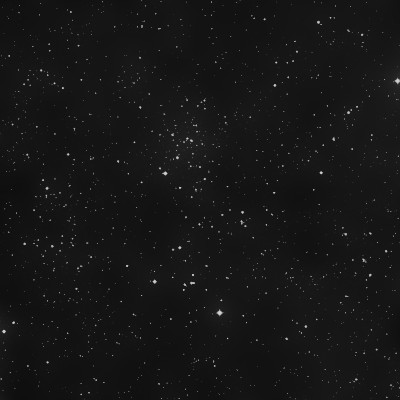
John Herschel discovered NGC 7261 = h2159 on 5 Oct 1829 and recorded "The chief star of a coarse p rich cluster which fills the field. Stars 10...15m." His position matches mag 9.6 HD 239927.
400/500mm - 17.5" (10/5/91): about 30 stars in a 7'x3' region elongated N-S. Set over a background of some unresolved haze on the north side of cluster. Includes six brighter stars with a mag 9 star on the SE side. Fairly rich in faint stars on the north side although not rich in other sections.
Notes by Steve Gottlieb
NGC 7142
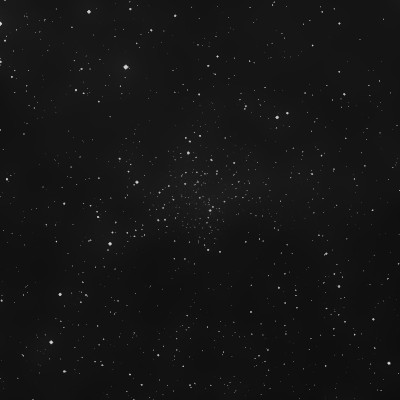
William Herschel discovered NGC 7142 = H VII-66 = h2134 on 18 Oct 1794 (sweep 1063) and recorded "a cl of considerable compressed vS stars, intermixed with some pretty large ones. iF, 8 or 9' diameter. Some of the large ones from an irregular kind of circle." On 16 Sept 1798 (sweep 1079) he logged "a cluster; considerably rich, chiefly small stars, about 12' diameter." JH made a single observation and recorded "the chief star in the sf part of a large, pretty rich, loose cluster of st 12...14m; diam 10'; has more than one star 10-11m in it." His position is on the double star HJ 1696 at the east side of the cluster.
200/250mm - 8" large, spread out. There is a string of stars on the east and SE edge.
300/350mm - 13.1" (7/20/85): fairly rich but somewhat scattered in parts, large. Includes three brighter mag 10 stars but otherwise fairly uniform and rich in mag 12.5-13.5 stars.
Notes by Steve Gottlieb
NGC 7076
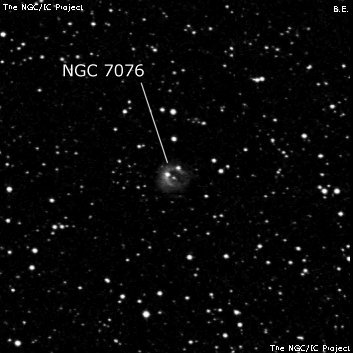
William Herschel discovered NGC 7076 = H III-936 on 15 Oct 1794 (sweep 1062) and noted "vF, easily resolvable." His position is 7 min 54 sec of RA east and 16' north of Alpha Cephei. Just 2' further north is the planetary Abell 75, which was catalogued by Abell but not associated with the NGC number. John Herschel did not make an observation of this planetary. It was not found during a single attempt on 15 Sep 1873 at Birr Castle.
The ESO-Strausberg planetary catalogue uses the Abell designation. RNGC lists NGC 7076 as a diffuse nebula instead of a planetary and furthermore the declination is 6' too far south. I found the equivalency between NGC 7076 and Abell 75 and listed it in RNGC Corrections #3.
400/500mm - 17.5" (7/5/86): fairly faint at 79x using an OIII filter, slightly elongated, moderately large, estimate V = 13.5-13.8. Faintly visible unfiltered. At 222x two stars are superimposed; a faint star east of center and one at the north edge. The planetary is collinear with two mag 14 stars 1' N and 2' N. Located 15' SE of mag 7.2 SAO 19386. Not identified as NGC 7076 in CGPN and ESO-Strausberg catalogues.
600/800mm - 24" (10/3/13): picked up unfiltered but very good contrast gain with a UHC filter at 225x. Appeared moderately bright, slightly elongated ~48"x40". Clearly brighter along the eastern side with the brightest portion directly east of center, giving a partially annular appearance. Unfiltered a mag 14.5 star is at the east edge and a mag 15 star is involved at the north edge. Two mag 13.5/14 stars just north are collinear with the planetary. Located in a rich star field 16' SE of mag 7.4 HD 204211.
Notes by Steve Gottlieb
IC 1454
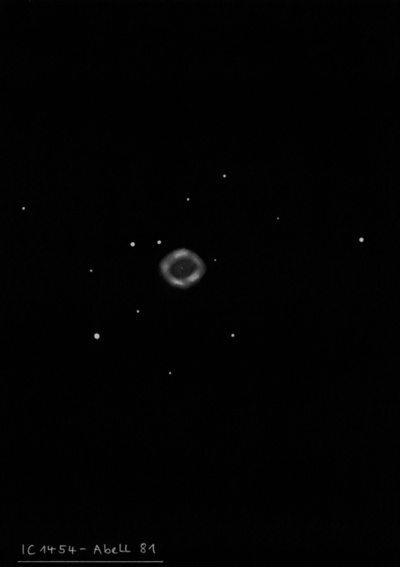
William Denning discovered IC 1454 on 9 Aug 1891 with his 10-inch reflector (announced in Observatory, 15, 104). He noted it was "rather a difficult object, except on a good night, though I picked it up with a power of only 40. It is noteworthy as being situated in the midst of a region containing very few nebulae." IC 1454 was found by Abell in 1955 on the POSS and listed as #67 of 73 new planetary nebulae. Abell recognized the earlier IC designation but included it in his list as it wasn't previously recognized as a planetary. In his second list (1966) IC 1454 was renumbered as Abell 81.
300/350mm - 13.1" (8/11/85): at 88x and OIII filter, fairly faint, fairly small, round. Located 4' W of a mag 7 star that detracts from viewing. At 166x with a UHC filter; easy to view, moderately large. Two very faint stars are involved near the NE edge.
400/500mm - 17.5" (10/13/01): picked up at 100x without filter as a faint, small disc situated 4' WNW of a mag 7 star. Excellent contrast gain with an OIII filter and appears as a round, 25" crisp-edged disc. At 220x without filter a faint mag 14/15 pair is at the NE edge. Very nice view using a UHC filter at 140x-220x; the PN was slightly elongated ~E-W but no other details are visible.
17.5" (8/8/91): moderately bright, fairly small, almost round, slightly elongated E-W, 30" diameter. A faint double star mag 14/15 is at the NE edge. Located 3.8' WNW of mag 7 SAO 3785. No central star visible. Pretty planetary at 220x without filter.
600/800mm - 24" (10/3/13): at 225x using an NPB filter, IC 1454 (Abell 81) appeared fairly bright, round, 30" diameter, crisp-edged. The planetary displayed a relatively large, brighter rim that was unevenly lit, and a small (~12"), slightly darker center. Unfiltered the annularity was more difficult to confirm, though the rim appeared slightly brighter on the south side. A pair of 14th magnitude stars are just off the NE side and a mag 13.4 star is 1' SE. Situated 4.3' W of mag 7 HD 215867.
Notes by Steve Gottlieb
NGC 7160
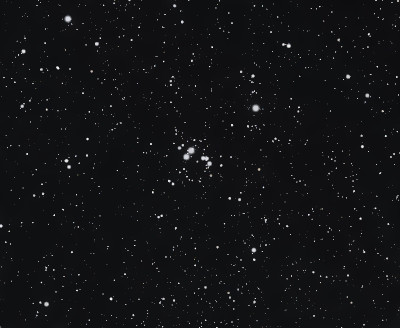
William Herschel discovered NGC 7160 = H VIII-67 = h2136 on 9 Nov 1787 (sweep 776) and recorded "a coarsely scattered cluster of stars of several sizes, 6 or 7' diam, a forming one." His position is accurate. Both William and John only made a single observation.
200/250mm - 8" (10/31/81): about two dozen stars in a bright cluster, not dense. Includes two mag 8 stars.
400/500mm - 17.5" (10/5/91): about three dozen stars in a 7' diameter. Very bright, elongated SW-NE although scattered outliers make the cluster rounder. Includes several fairly bright stars with two stars mag 7.0/7.9 at 1.0' separation NE of center which are surrounded by a semicircle of nine stars. Includes several double stars with a mag 10 star that has a very faint companion on its west side. Not rich but distinctive. Mag 6.8 SAO 19698 is 11' NW at the edge of the field.
Notes by Steve Gottlieb
NGC 7226
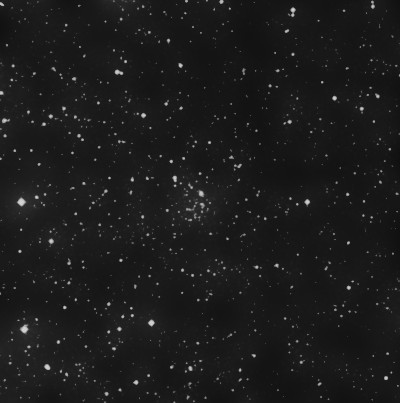
Edward Holden discovered NGC 7226 on 20 Jun 1881 with the 15.6" Clark refractor at the Washburn Observatory and described a "pB nebula connected with a small cluster of stars which radiate in two streams from the f[ollowing] to p[receding] side. Diam of Neb 5', of Cl. 15'. North-preceding in p[osition angle] 315° is a small knot which may be nebulous." His position is just off the east side of this small cluster.
400/500mm - 17.5" (11/2/91): 15 stars resolved at 220x within a compact 2' diameter. The brightest mag 11 star is at the WNW edge and a close double star mag 12/13 at 11" is at the NE edge. The remaining dozen very faint stars are 14th and 15th mag and located along the south side. Situated in a rich star field over unresolved background haze.
Notes by Steve Gottlieb
NGC 2276
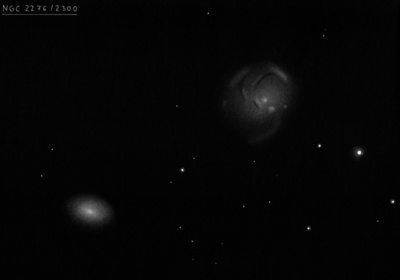
Friedrich August Winnecke discovered NGC 2276 on 26 Jun 1876 with the 6.5" refractor at the Strausberg Observatory. Wilhelm Tempel independently discovered the galaxy the same year with the 11" refractor at the Arcetri Observatory and included it in his first list (#20). Winnecke also thought he discovered NGC 2300 but Borrelly found that galaxy earlier (either 1871 or 1872) at Marseille. NGC 2276 is the 3rd closest to the pole in the NGC or IC.
200/250mm - 8" (1/1/84): faint, moderately large, low surface brightness, slightly elongated. A mag 9 star is near.
300/350mm - 13.1" (1/18/85): diffuse, slightly elongated. Located 2.2' ENE of mag 8.4 SAO 1148 which interferes with viewing. Three mag 11 stars also in line with the 8.4 star to the south including a mag 11.5 star just 1.4' SW. Forms a pair with NGC 2300 6.4' ESE.
400/500mm - 18" (8/2/11): moderately bright, large, round, ~2.0' diameter, weak concentration, slightly brighter core. The halo has an irregular surface brightness giving a strong impression of spiral structure with slightly brighter knots on the west side. Located 2.3' ENE of mag 8.1 HD 51141, which hinders viewing and a mag 11.7 star is squeezed between the bright star and the galaxy. Brighter NGC 2300 lies 6' SE. These are the 3rd and 4th closest NGC galaxies to the North Celestial Pole.
18" (3/13/04): fairly faint, large, slightly elongated,~2.0'x1.6', low surface brightness. The halo fades gradually into the background, particularly on the eastern side, so it was difficult to determine a definite edge. Located 2.2' E of mag 8.4 SAO 1148 which detracts from viewing. Forms a trio with NGC 2300 6' SE and IC 455.
600/800mm - 24" (9/15/12): moderately bright, fairly large, round, 2' diameter. Although spiral arms were not visible, the galaxy has an odd appearance with brighter knots and regions resolved. A non-stellar knot, identified in NED as NGC 2276:[HK83] 69 is visible at the NW edge. The central region contains a faint quasi-stellar nucleus, along with one or two other stellar knots including NGC 2276:[HK83] 24, close east of the nucleus. Another knot (nonstellar) is southwest of the nucleus (perhaps NGC 2276:[HK83] 63). The halo appears weaker on the east side and brighter on the west side. Located 2.3' ENE of a mag 8 star and it helps to move the star just outside the field.
900/1200mm - 48" (4/4/13): at 488x, NGC 2276 appeared fairly bright, fairly large, irregularly round, 2' diameter. Contains a very small, very bright nucleus, surrounded by a patchy halo with weak spiral structure. The most prominent arm winds along the western edge of the galaxy, curving from west to northwest and creating a very asymmetric appearance. Along this arm segment is a prominent knotty section with two or three clumps, including [HK83] 69, a bright 6" knot. On the southwest side of the halo is [HK83] 63, a faint 6" knot on a line between the nucleus and the 8th-magnitude star (HD 51141) 2.3' SW. In the brighter central region surrounding the nucleus are several brighter, small patches that define the inner arms. A slightly brighter region close southwest of the nucleus includes the multiple designations [HK83] 17/42/46/51. Finally, [H83] 24/27 are weak enhancements on the southeast side of the nucleus. HII region #24 was the site of SN 2005dl.
Notes by Steve Gottlieb
NGC 1184
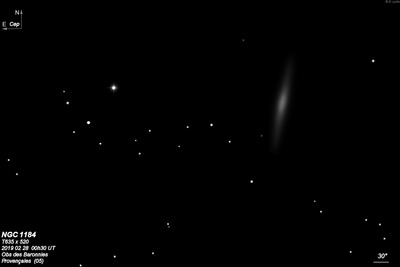
William Herschel discovered NGC 1184 = H II-704 on 16 Sep 1787 (sweep 757) and recorded "F, pL, mE from np to sf, lbM." Auwer's reduced position is ~5' north of MCG -02-08-041 = PGC 11488, although the NGC position is accurate. This galaxy is the third closest galaxy to the north celestial pole discovered by WH (after NGC 6251 and 6252).
400/500mm - 17.5" (10/20/90): fairly faint, fairly small, edge-on 4:1 NNW-SSE, sharp concentration, stellar nucleus. This is a pretty edge-on system with a bulging core and tapering extensions.
Notes by Steve Gottlieb
NGC 7822
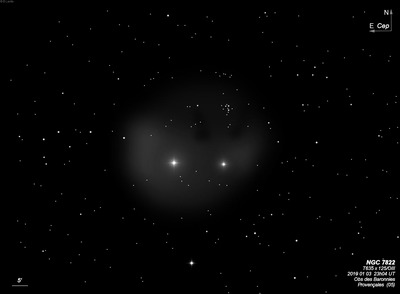
John Herschel discovered NGC 7822 = h2302 on 16 Nov 1829 and recorded "the central part of what I am positive is an enormously L, but eF neb of a round figure, though I cannot trace its limits. Diam 10'±. The night exquisite. I swept often across it to be sure, but always recurred to the same place. No doubt but can never be seen but in the best state of the air and sky. Diameter 10' +/-." Herschel's position is just north of the 60'x30' nebula described here, though it is not of a "round figure". Two unsuccessful obsesrvations were made with LdR's 72", probably due to the size.
Isaac Roberts gave dimensions of 42'x38' in MNRAS, Vol LXIII, p301 based on plates taken in 1901 and 1902, although his description (as well as possibly JH's) refers to Ced 214 = Sh 2-171, about 1.5° south of JH's position (part of the same complex). Dreyer repeated Robert's dimensions in the IC 2 Notes section. Harold Corwin's favors identifying Robert's nebula as NGC 7822, with Ced 215 (close to JH's position) as a secondary choice. Either are possible, but as JH didn't mention the mag 5.7 star involved in Ced 214, I prefer Ced 215.
400/500mm - 17.5" (8/25/95): very faint, very large nebulosity best viewed in the 16x80 finder as it gives a higher contrast with the surrounding sky. Appears elongated E-W and at least 40' in size. At 82x, nebulosity is clearly visible in the region of a triangle of mag 8-9 stars including mag 7.9 SAO 20996 at 00 00 57.5 +68 27 27 (2000). A large portion of the field appears weakly nebulous, though not with certainty.
The identification of NGC 7822 is uncertain and may apply to Ced 214 about 1.5 degrees to the south. Here are my descriptions for Ced 214 = Sh 2-171:
17.5" (10/4/97): Ced 214 was not detected unfiltered at 82x or using an OIII filter. With an H-Beta filter, a 40' field surrounding the mag 5.7 illuminating star appeared weakly nebulous in contrast to the immediate periphery. No structure noted, although seemed roughly circular. The small open cluster Be 59 is embedded on the NW side. This object may be NGC 7822 if John Herschel made a 1.5 degree error in declination.
Notes by Steve Gottlieb
IC 1470
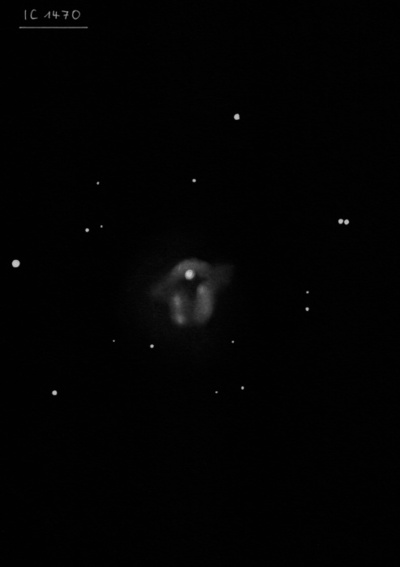
Rudolph Spitaler discovered IC 1470 = Sp 62 on 20 Mar 1892 while observing Comet 1892 II (Denning). Both C.F. Pechüle, as well as Barnard (AN 3110 and AJ 11), also found this emission nebula just a day later while observing the comet!
300/350mm - 13.1" (9/22/84): appears as a mag 12 star with a faint but easily visible oval nebula surrounding the star. Extends mainly SE with the 12th magnitude star at the tip. Visible without a filter. Similar to Hubble's Variable Nebula.
400/500mm - 17.5" (10/30/99): picked up at 100x using an OIII filter as a small, bright glow surrounding a mag 12 star. Best view at 280x unfiltered. The involved star is attached at the north edge and the 1' oval nebula appears to hang off the south side of the star. Close west is a very close, evenly matched faint double star!
Notes by Steve Gottlieb
NGC 6951
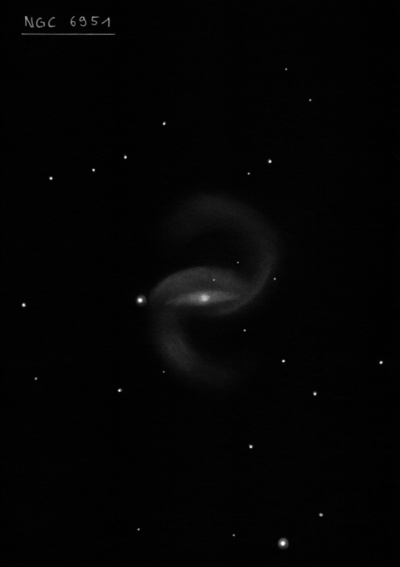
| Type | GX [SBbc] |
| RA | 20:37:14.0 |
| Dec | +66:06:21.0 |
| major_axis | 3.9' |
| minor_axis | 3.2' |
| position_angle | 170.0 |
| mag | 10.7 |
| surface_bright | 13.2 |
M 2-51
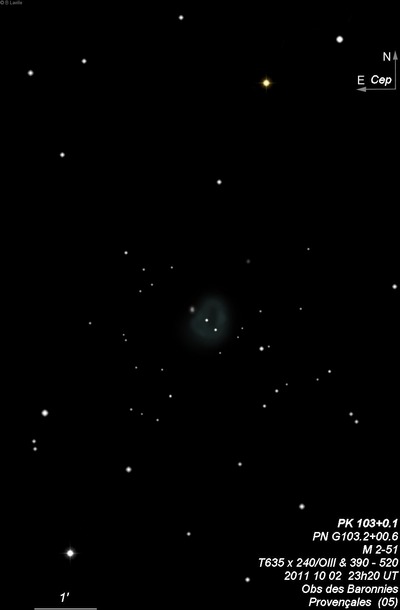
| Type | PN [2(3)] |
| RA | 22:16:03.9 |
| Dec | +57:28:34.0 |
| major_axis | 72.0'' |
| mag | 13.5 |
| surface_bright | 13.6 |
Pal 1
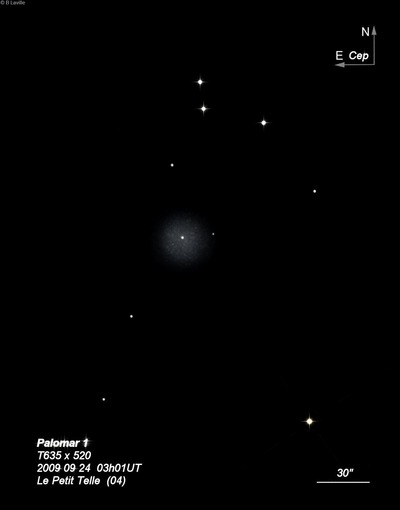
| Type | GC |
| RA | 03:33:18.0 |
| Dec | +79:35:00.0 |
| major_axis | 2.8' |
| mag | 13.6 |
| surface_bright | 15.6 |
M 2-52
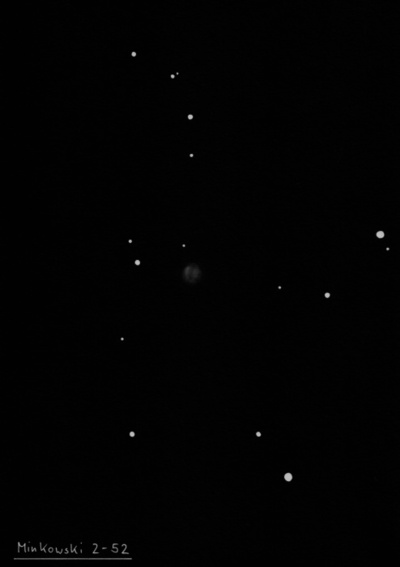
| Type | PN |
| RA | 22:20:30.4 |
| Dec | +57:36:20.0 |
| major_axis | 12.0'' |
| minor_axis | 12.0'' |
| mag | 14.0 |
| surface_bright | 10.3 |
M 1-80
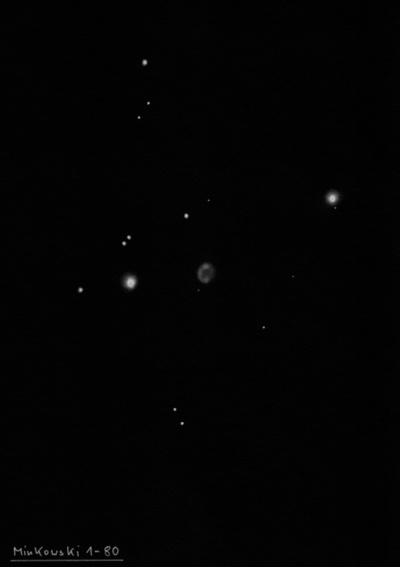
| Type | PN |
| RA | 22:56:19.9 |
| Dec | +57:09:21.0 |
| major_axis | 6.0'' |
| minor_axis | 18.0'' |
| mag | 14.2 |
| surface_bright | 9.5 |
M 2-55
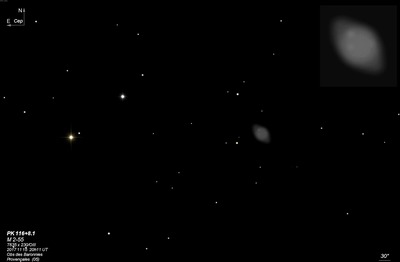
| Type | PN |
| RA | 23:31:52.7 |
| Dec | +70:22:10.0 |
| major_axis | 66.0'' |
| minor_axis | 48.0'' |
| mag | 14.3 |
| surface_bright | 13.8 |
K 3-63
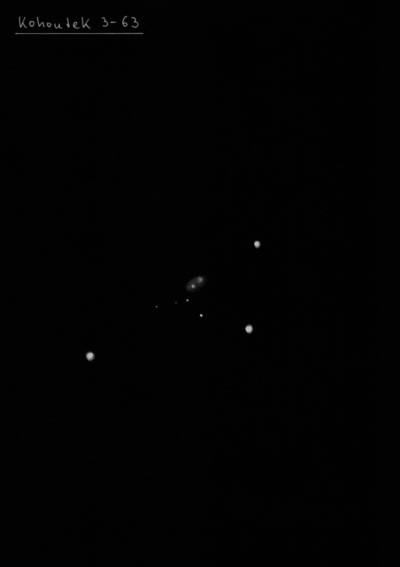
| Type | PN |
| RA | 21:39:12.0 |
| Dec | +55:46:04.0 |
| major_axis | 6.0'' |
| minor_axis | 24.0'' |
| position_angle | 1.0 |
| mag | 15.9 |
| surface_bright | 11.0 |
Sh2-128
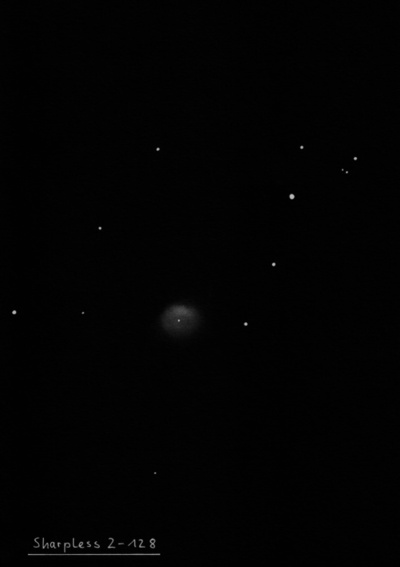
| Type | BN [HII] |
| RA | 21:32:10.4 |
| Dec | +55:52:42.0 |
| major_axis | 78.0'' |
| minor_axis | 48.0'' |
| mag | 16.4 |
| surface_bright | 16.2 |
Abell 86
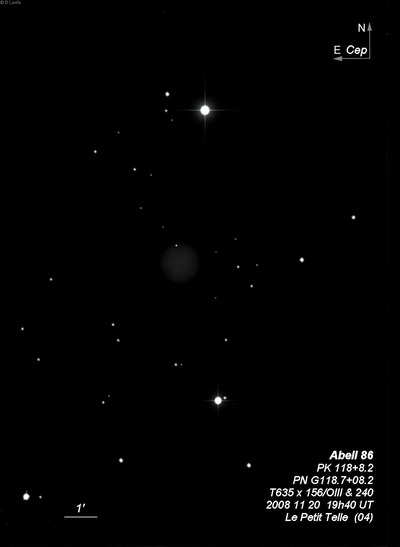
| Type | PN [2c] |
| RA | 00:01:31.0 |
| Dec | +70:42:30.0 |
| major_axis | 72.0'' |
| mag | 16.7 |
| surface_bright | 16.8 |
Abell 73
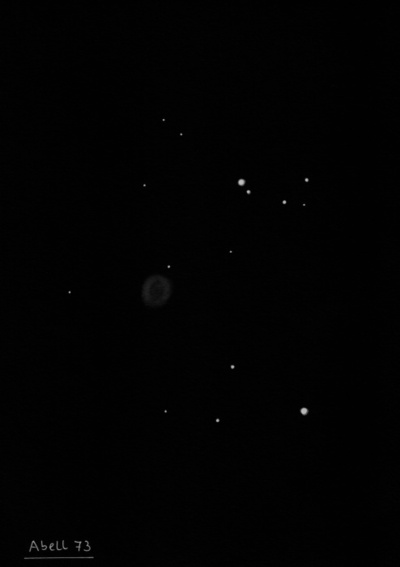
| Type | PN |
| RA | 20:56:27.0 |
| Dec | +57:26:03.0 |
| major_axis | 78.0'' |
| minor_axis | 66.0'' |
| mag | 17.4 |
| surface_bright | 17.6 |
Abell 1
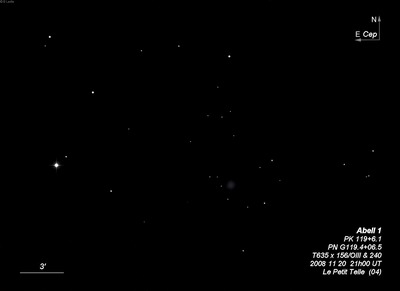
| Type | PN [2b] |
| RA | 00:12:55.0 |
| Dec | +69:10:24.0 |
| major_axis | 48.0'' |
| mag | 18.3 |
| surface_bright | 17.5 |
Sh2-174
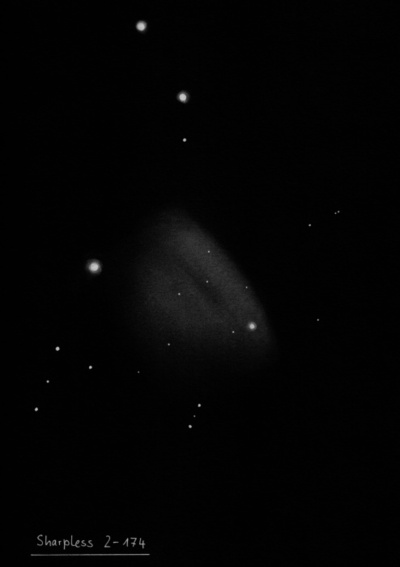
| Type | PN |
| RA | 23:45:02.3 |
| Dec | +80:57:00.0 |
| major_axis | 15.0' |
| minor_axis | 10.0' |
Sh2-130
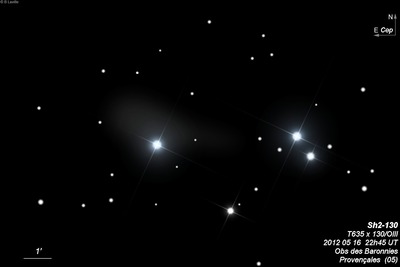
| Type | BN [HII] |
| RA | 20:43:00.1 |
| Dec | +63:13:40.0 |
| major_axis | 3.0' |
Sh2-136
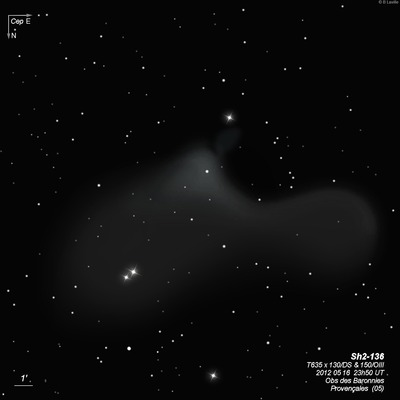
| Type | BN [HII] |
| RA | 21:16:30.1 |
| Dec | +68:15:09.0 |
| major_axis | 5.0' |
Sh2-155
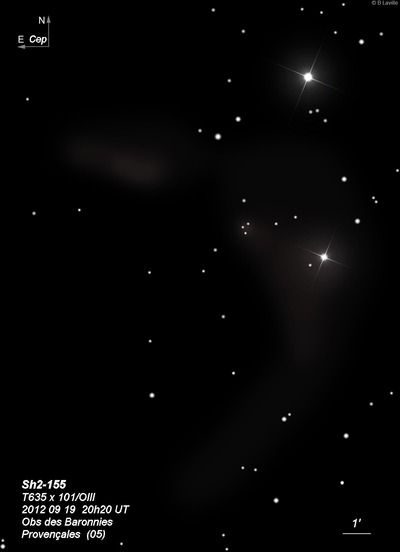
| Type | BN [HII] |
| RA | 22:56:48.0 |
| Dec | +62:37:00.0 |
| major_axis | 50.0' |
| minor_axis | 30.0' |
